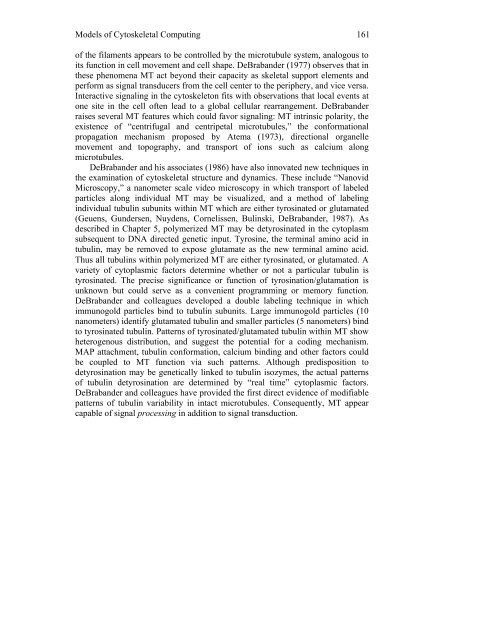ULTIMATE COMPUTING - Quantum Consciousness Studies
ULTIMATE COMPUTING - Quantum Consciousness Studies
ULTIMATE COMPUTING - Quantum Consciousness Studies
- No tags were found...
Create successful ePaper yourself
Turn your PDF publications into a flip-book with our unique Google optimized e-Paper software.
Models of Cytoskeletal Computing 161<br />
of the filaments appears to be controlled by the microtubule system, analogous to<br />
its function in cell movement and cell shape. DeBrabander (1977) observes that in<br />
these phenomena MT act beyond their capacity as skeletal support elements and<br />
perform as signal transducers from the cell center to the periphery, and vice versa.<br />
Interactive signaling in the cytoskeleton fits with observations that local events at<br />
one site in the cell often lead to a global cellular rearrangement. DeBrabander<br />
raises several MT features which could favor signaling: MT intrinsic polarity, the<br />
existence of “centrifugal and centripetal microtubules,” the conformational<br />
propagation mechanism proposed by Atema (1973), directional organelle<br />
movement and topography, and transport of ions such as calcium along<br />
microtubules.<br />
DeBrabander and his associates (1986) have also innovated new techniques in<br />
the examination of cytoskeletal structure and dynamics. These include “Nanovid<br />
Microscopy,” a nanometer scale video microscopy in which transport of labeled<br />
particles along individual MT may be visualized, and a method of labeling<br />
individual tubulin subunits within MT which are either tyrosinated or glutamated<br />
(Geuens, Gundersen, Nuydens, Cornelissen, Bulinski, DeBrabander, 1987). As<br />
described in Chapter 5, polymerized MT may be detyrosinated in the cytoplasm<br />
subsequent to DNA directed genetic input. Tyrosine, the terminal amino acid in<br />
tubulin, may be removed to expose glutamate as the new terminal amino acid.<br />
Thus all tubulins within polymerized MT are either tyrosinated, or glutamated. A<br />
variety of cytoplasmic factors determine whether or not a particular tubulin is<br />
tyrosinated. The precise significance or function of tyrosination/glutamation is<br />
unknown but could serve as a convenient programming or memory function.<br />
DeBrabander and colleagues developed a double labeling technique in which<br />
immunogold particles bind to tubulin subunits. Large immunogold particles (10<br />
nanometers) identify glutamated tubulin and smaller particles (5 nanometers) bind<br />
to tyrosinated tubulin. Patterns of tyrosinated/glutamated tubulin within MT show<br />
heterogenous distribution, and suggest the potential for a coding mechanism.<br />
MAP attachment, tubulin conformation, calcium binding and other factors could<br />
be coupled to MT function via such patterns. Although predisposition to<br />
detyrosination may be genetically linked to tubulin isozymes, the actual patterns<br />
of tubulin detyrosination are determined by “real time” cytoplasmic factors.<br />
DeBrabander and colleagues have provided the first direct evidence of modifiable<br />
patterns of tubulin variability in intact microtubules. Consequently, MT appear<br />
capable of signal processing in addition to signal transduction.






